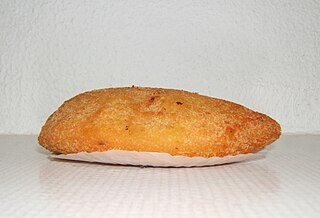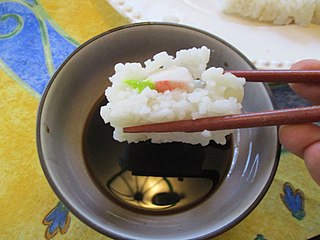
A fritter is a portion of meat, seafood, fruit, vegetables, or other ingredients which have been battered or breaded, or just a portion of dough without further ingredients, that is deep-fried. Fritters are prepared in both sweet and savory varieties.

Onion rings is a form of appetizer or side dish in British and American cuisine. They generally consist of a cross-sectional "ring" of onion dipped in batter or bread crumbs and then deep fried; a variant is made with onion paste. While typically served as a side dish, onion rings are often eaten by themselves.

A rissole is a small patty enclosed in pastry or rolled in breadcrumbs, usually baked or deep fried. The filling has savory ingredients, most often minced meat, fish or cheese, and is served as an entrée, main course, or side dish.

A dip or dip sauce is a common condiment for many types of food. Dips are used to add flavor or texture to a food, such as pita bread, dumplings, crackers, chopped raw vegetables, fruits, seafood, cubed pieces of meat and cheese, potato chips, tortilla chips, falafel, and sometimes even whole sandwiches in the case of jus. Unlike other sauces, instead of applying the sauce to the food, the food is typically placed or dipped into the sauce.

Peanut sauce, satay sauce, bumbu kacang, sambal kacang, or pecel is an Indonesian sauce made from ground roasted or fried peanuts, widely used in Indonesian cuisine and many other dishes throughout the world.

Nigerian cuisine consists of dishes or food items from the hundreds of Native African ethnic groups that comprises Nigeria. Like other West African cuisines, it uses spices and herbs with palm oil or groundnut oil to create deeply flavored sauces and soups.

Javanese cuisine is the cuisine of Javanese people, a major ethnic group in Indonesia, more precisely the province of Central Java, Yogyakarta and East Java.

Squid is eaten in many cuisines; in English, the culinary name calamari is often used for squid dishes. There are many ways to prepare and cook squid. Fried squid is common in the Mediterranean. In New Zealand, Australia, the United States, Canada, and South Africa, it is sold in fish and chip shops, and steakhouses. In Britain, it can be found in Mediterranean 'calamari' or Asian 'salt and pepper fried squid' forms in various establishments, often served as a bar snack, street food, or starter.

Beninese cuisine involves many fresh meals served with a variety of sauces. Meat is usually quite expensive, and meals are generally light on meat and generous on vegetable fat.

A croquette is a deep-fried roll originating in French cuisine, consisting of a thick binder combined with a filling, which is then breaded. It is served as a side dish, a snack, or fast food worldwide.

Nasi lengko in Indonesian, also known as sega lengko is a typical Cirebonese dish in Cirebon, Indramayu, Brebes, Tegal and surrounding areas.

Spring rolls are rolled appetizers or dim sum commonly found in Chinese and Southeast Asian cuisines. The kind of wrapper, fillings, and cooking technique used, as well as the name, vary considerably depending on the region's culture, though they are generally filled with vegetables.

Burmese fritters are traditional fritters consisting of vegetables or seafood that have been battered and deep-fried. Assorted fritters are called a-kyaw-sone. Burmese fritters are generally savory, and often use beans and pulses, similar to South Asian vada.

Cilok is an Indonesian ball-shaped dumpling made from aci, a Sundanese snack originated from Indonesia. In Sundanese, cilok is an abbreviation of aci dicolok or "poked tapioca", since the tapioca balls are poked with lidi skewers made from the midrib of the coconut palm frond.

Indo cuisine is a fusion cooking and cuisine tradition, mainly existing in Indonesia and the Netherlands, as well as Belgium, South Africa and Suriname. This cuisine characterized of fusion cuisine that consists of original Indonesian cuisine with Eurasian-influences—mainly Dutch, also Portuguese, Spanish, French and British—and vice versa. Nowaday, not only Indo people consume Indo cuisine, but also Indonesians and Dutch people.















